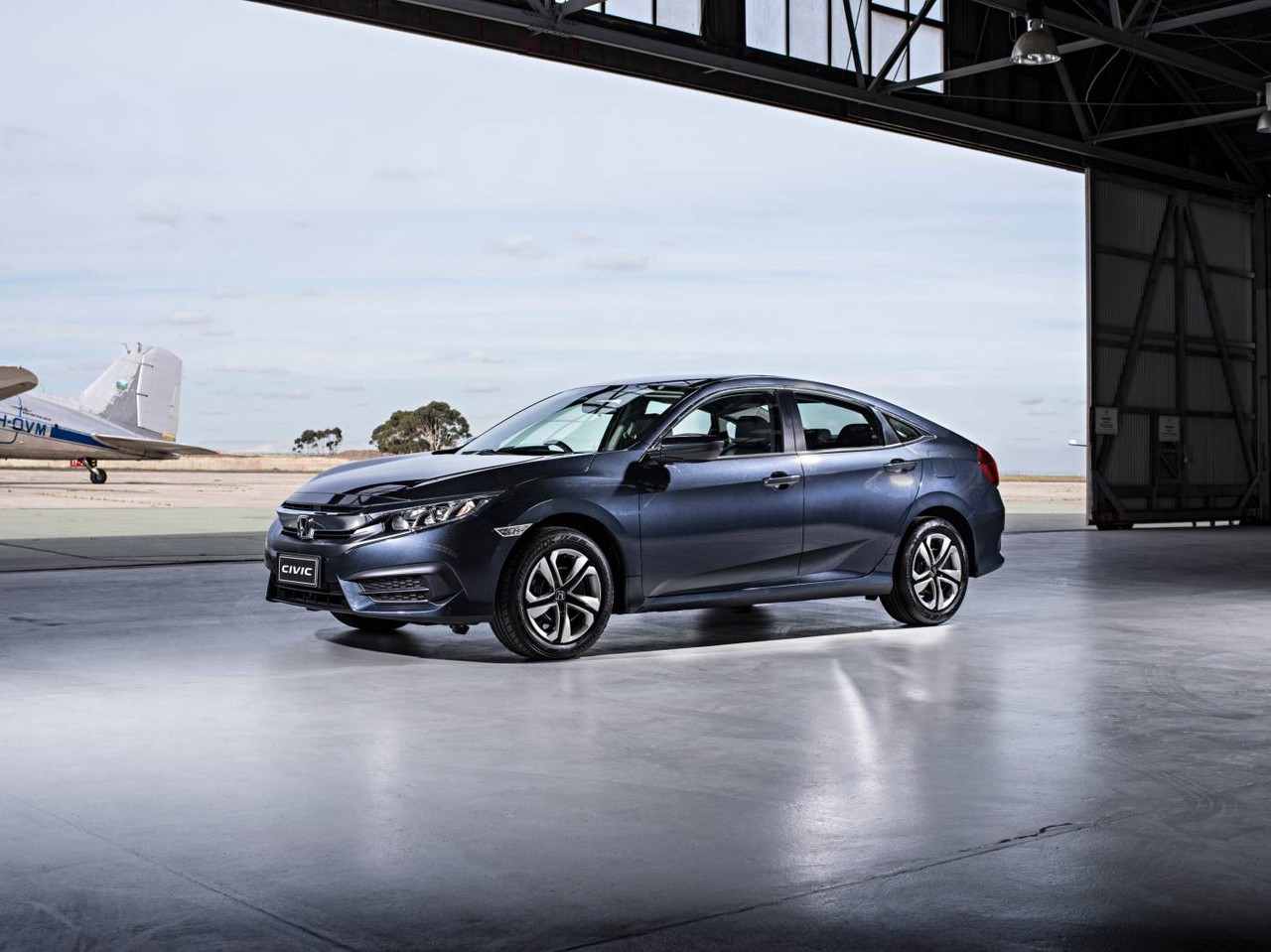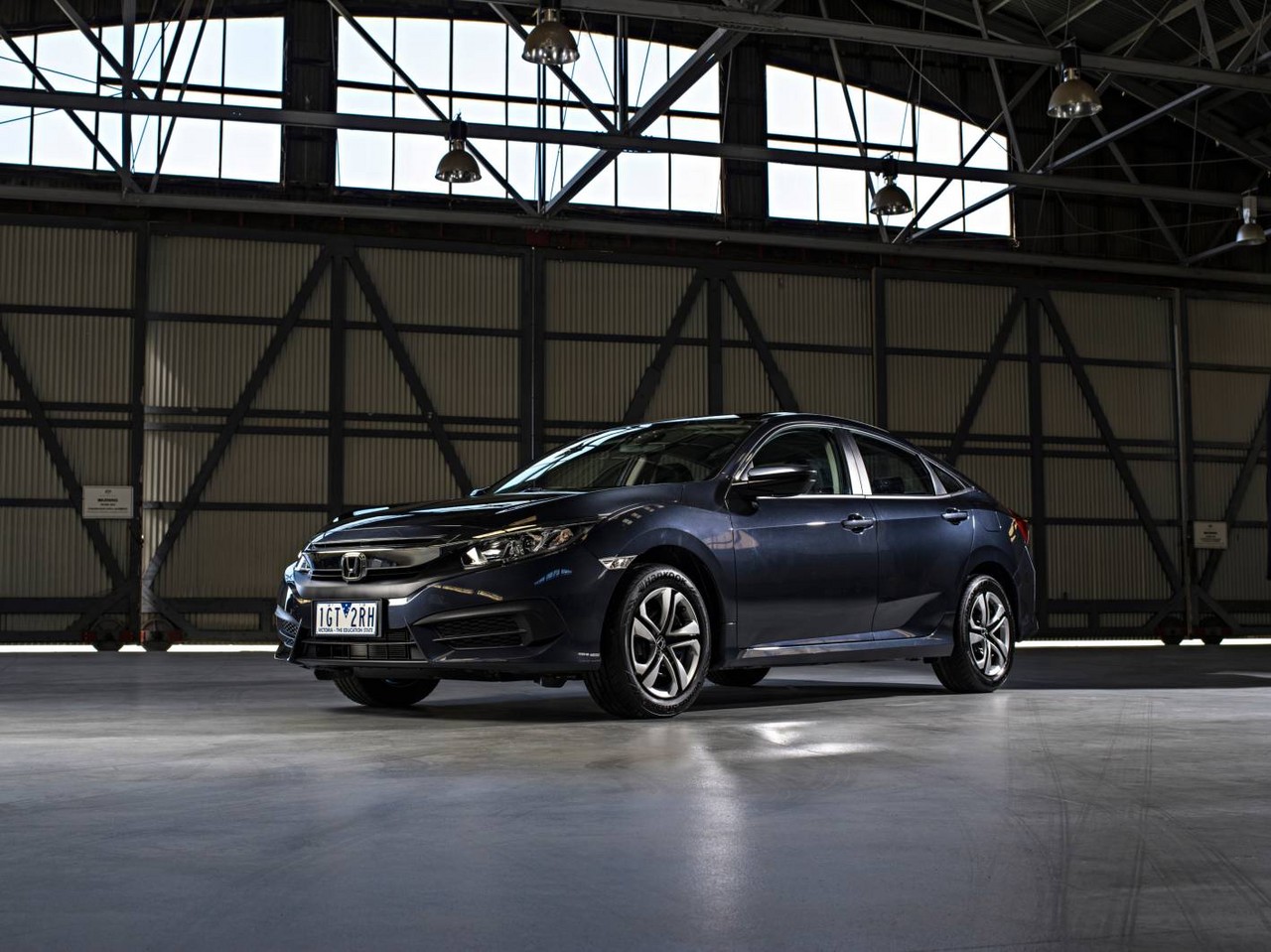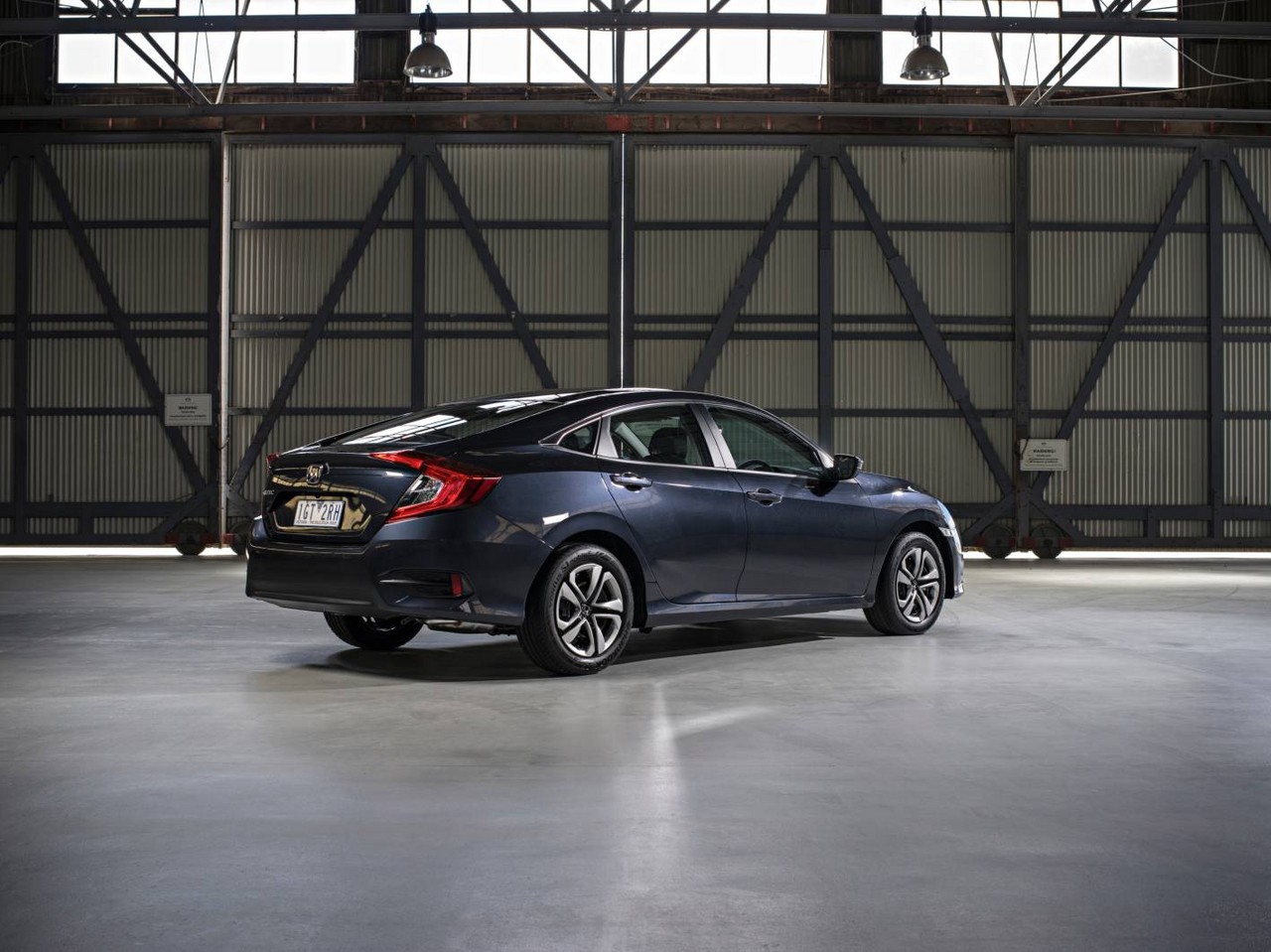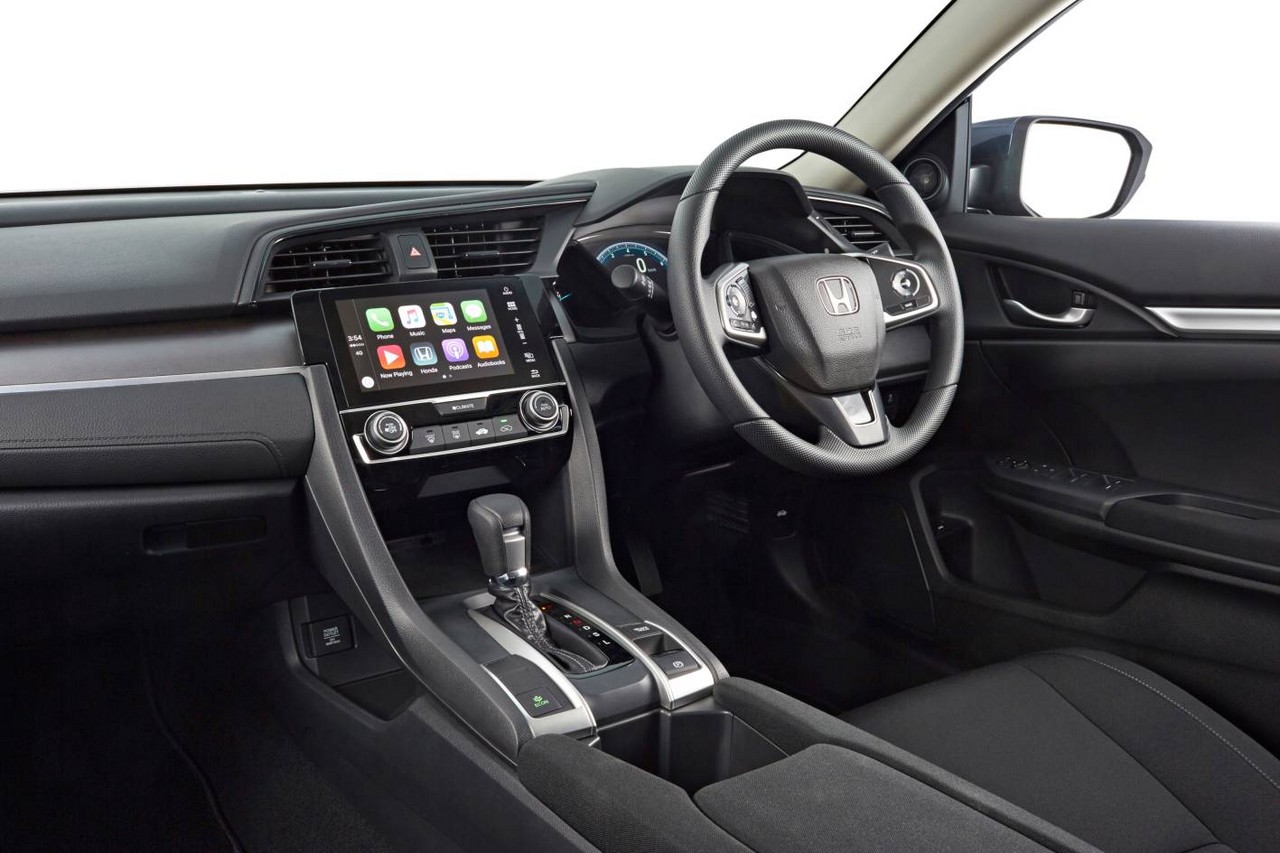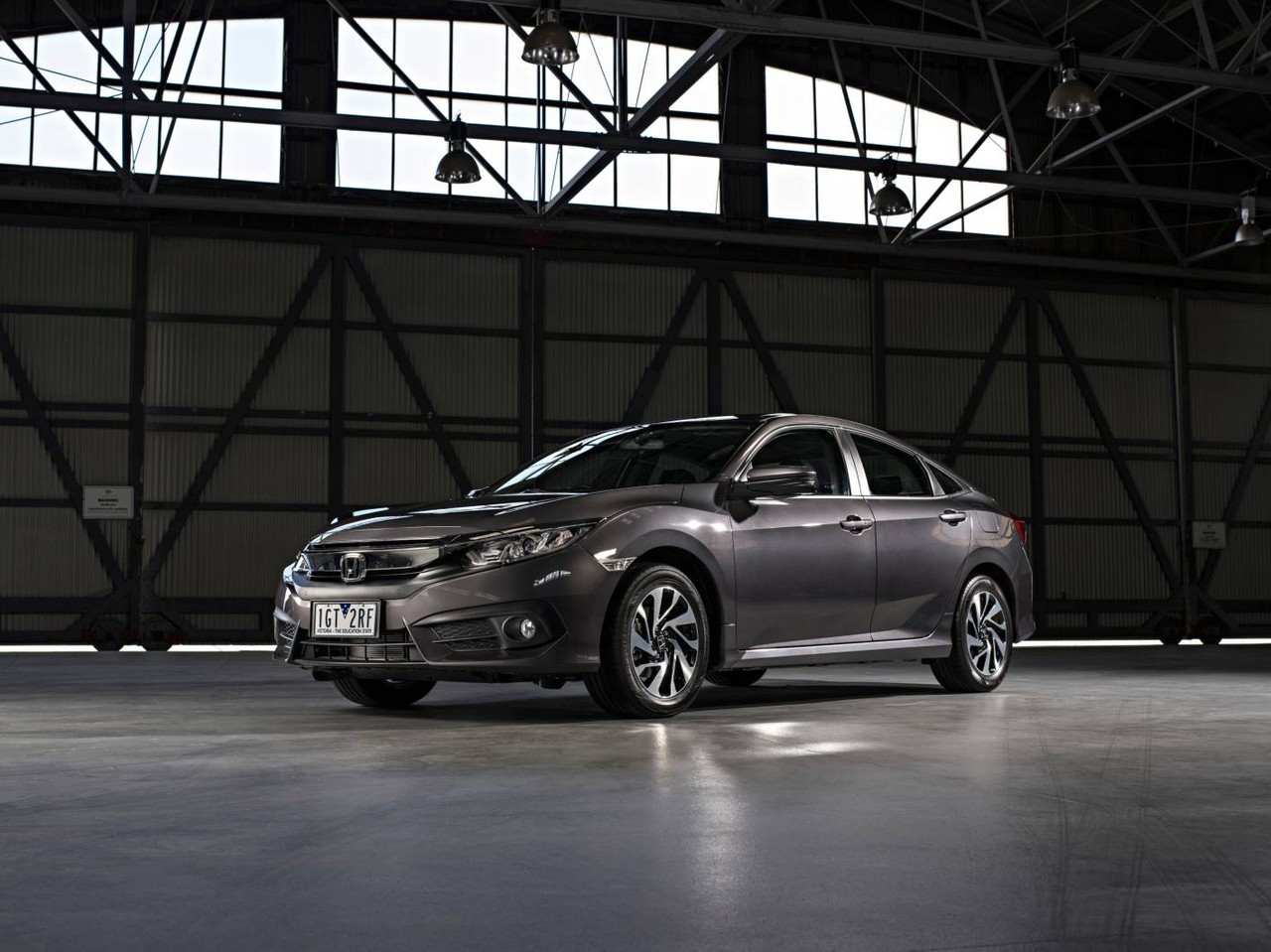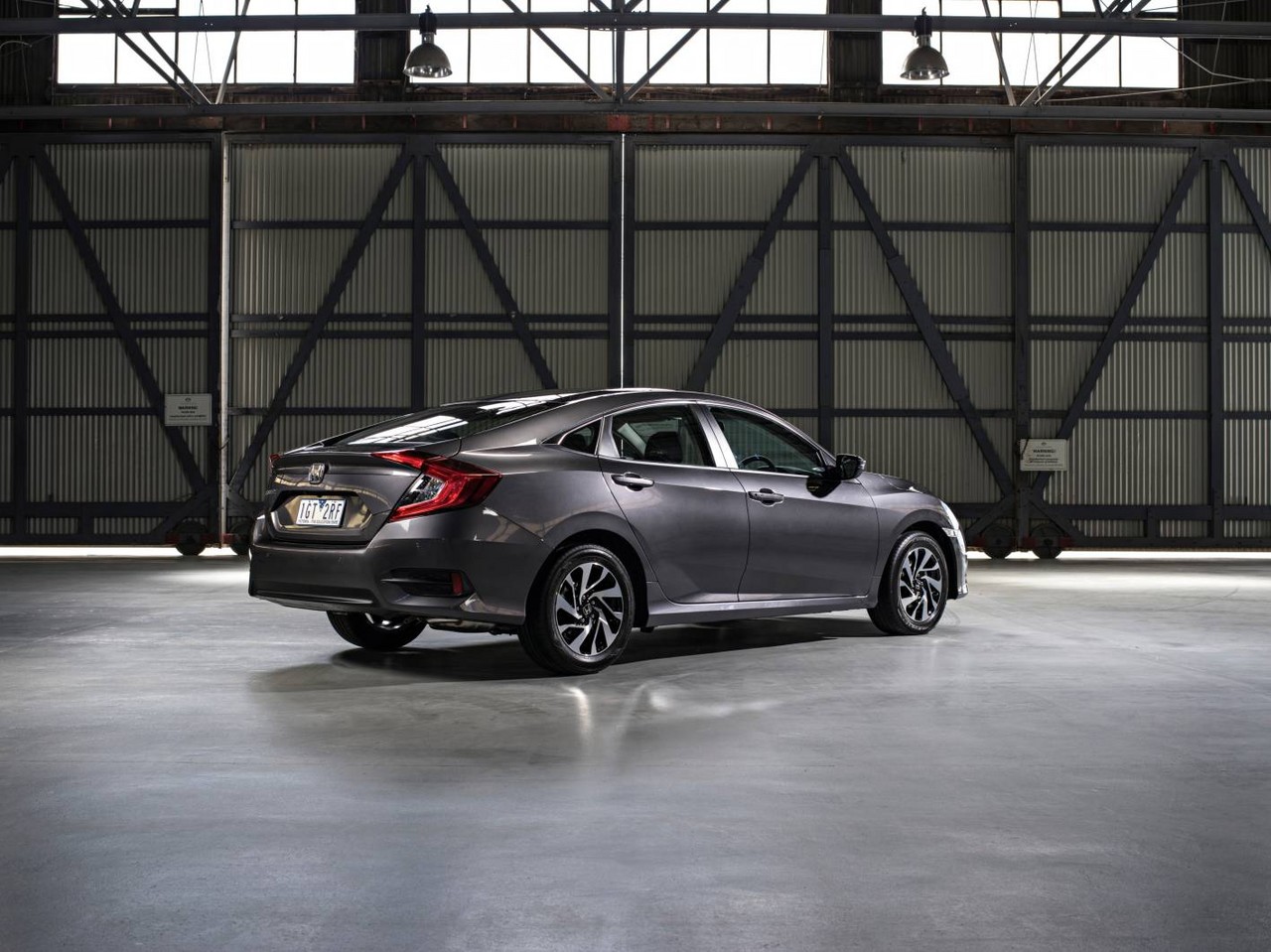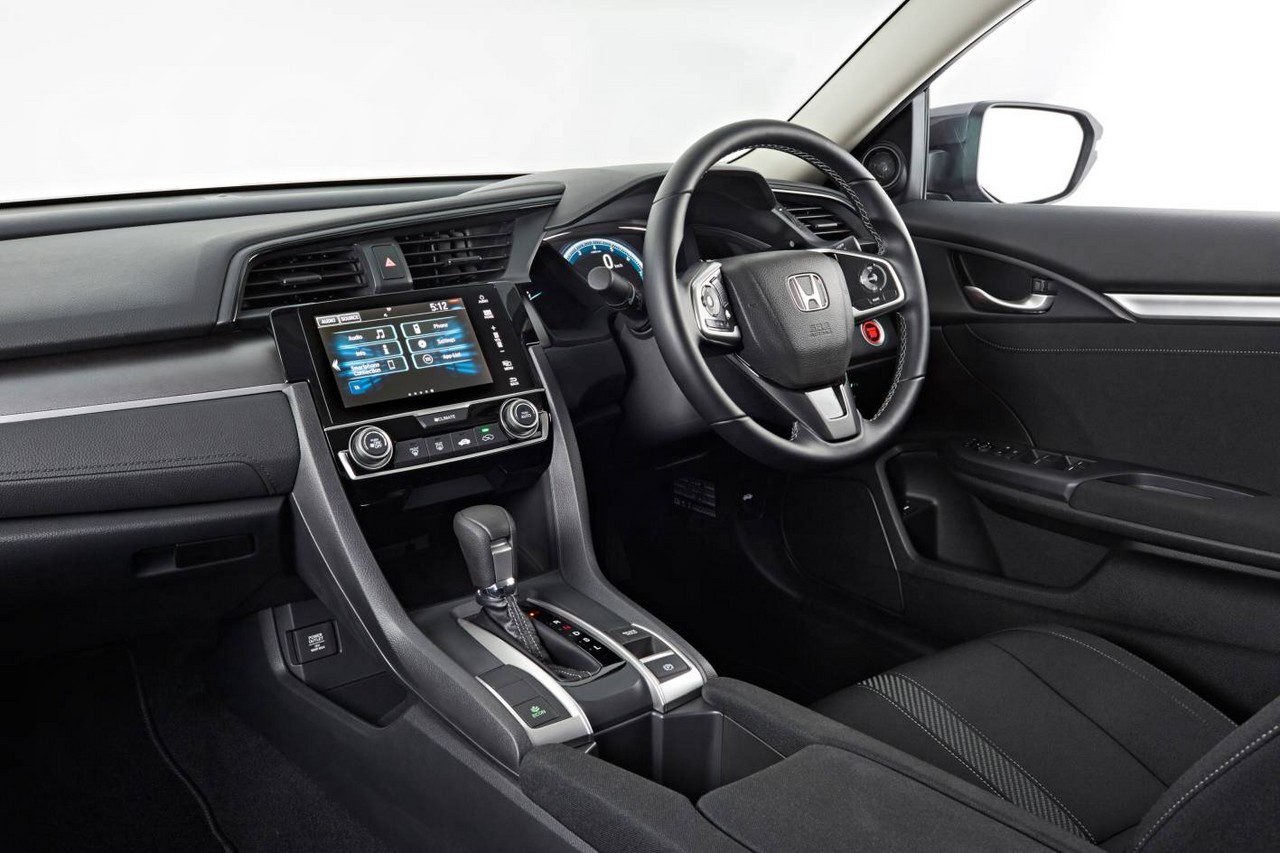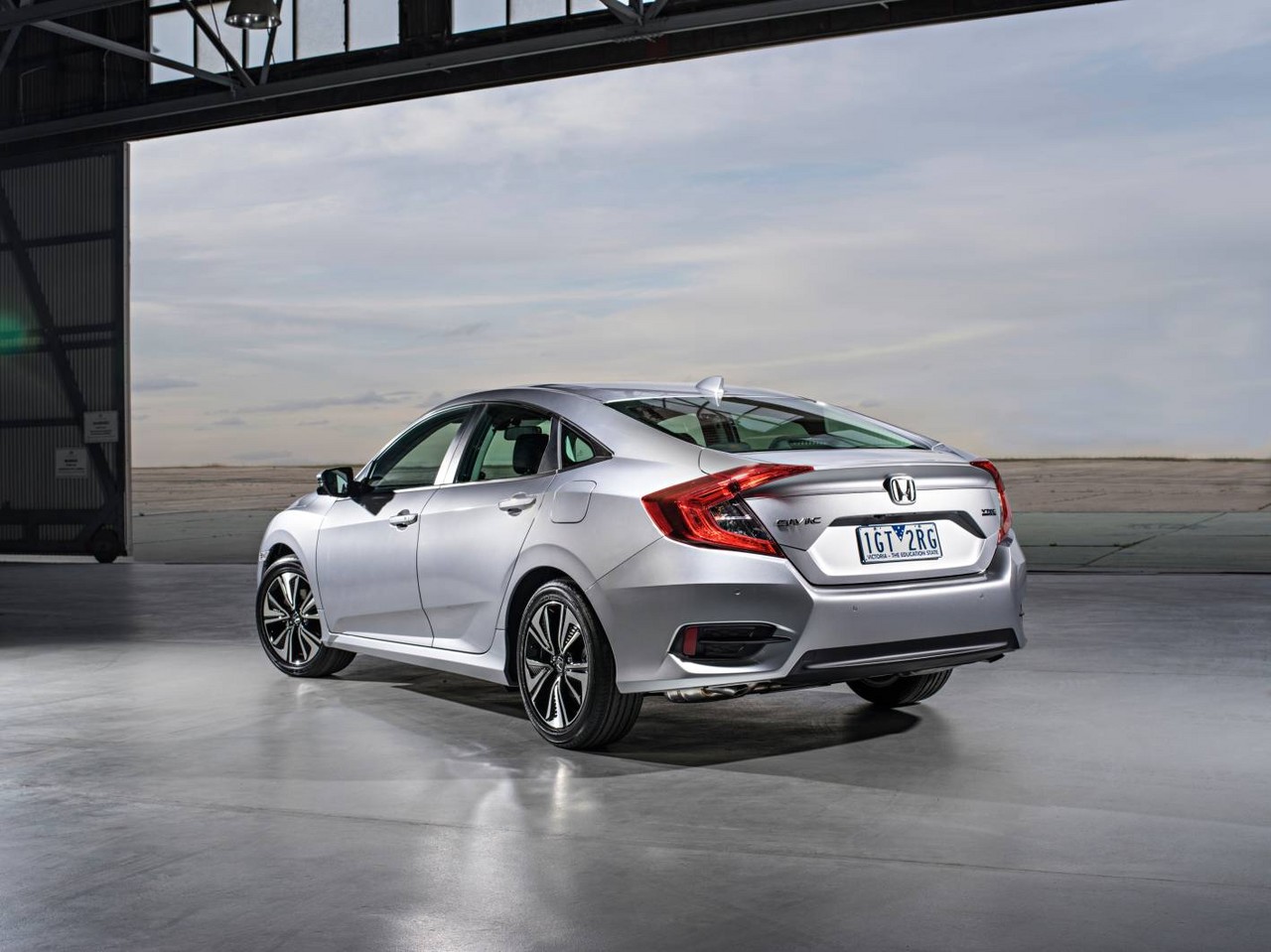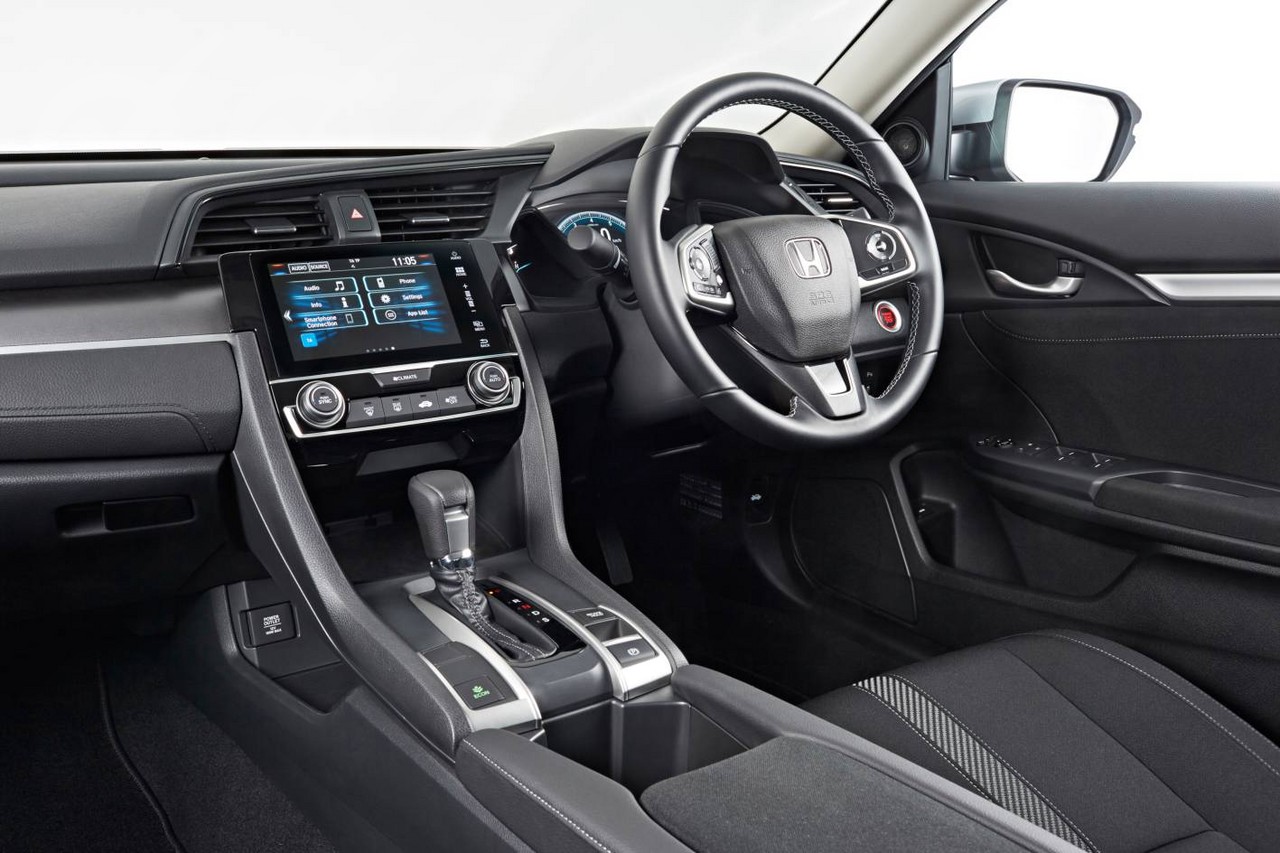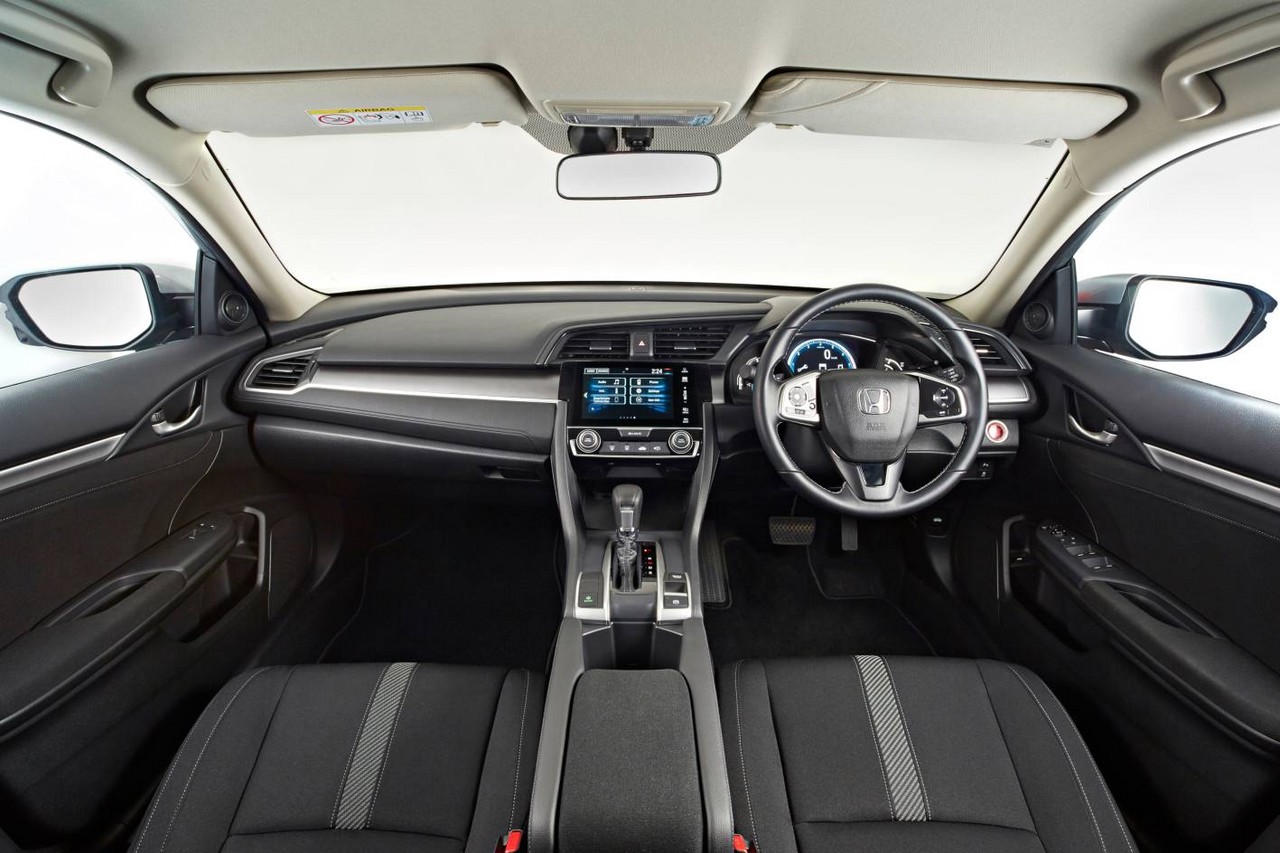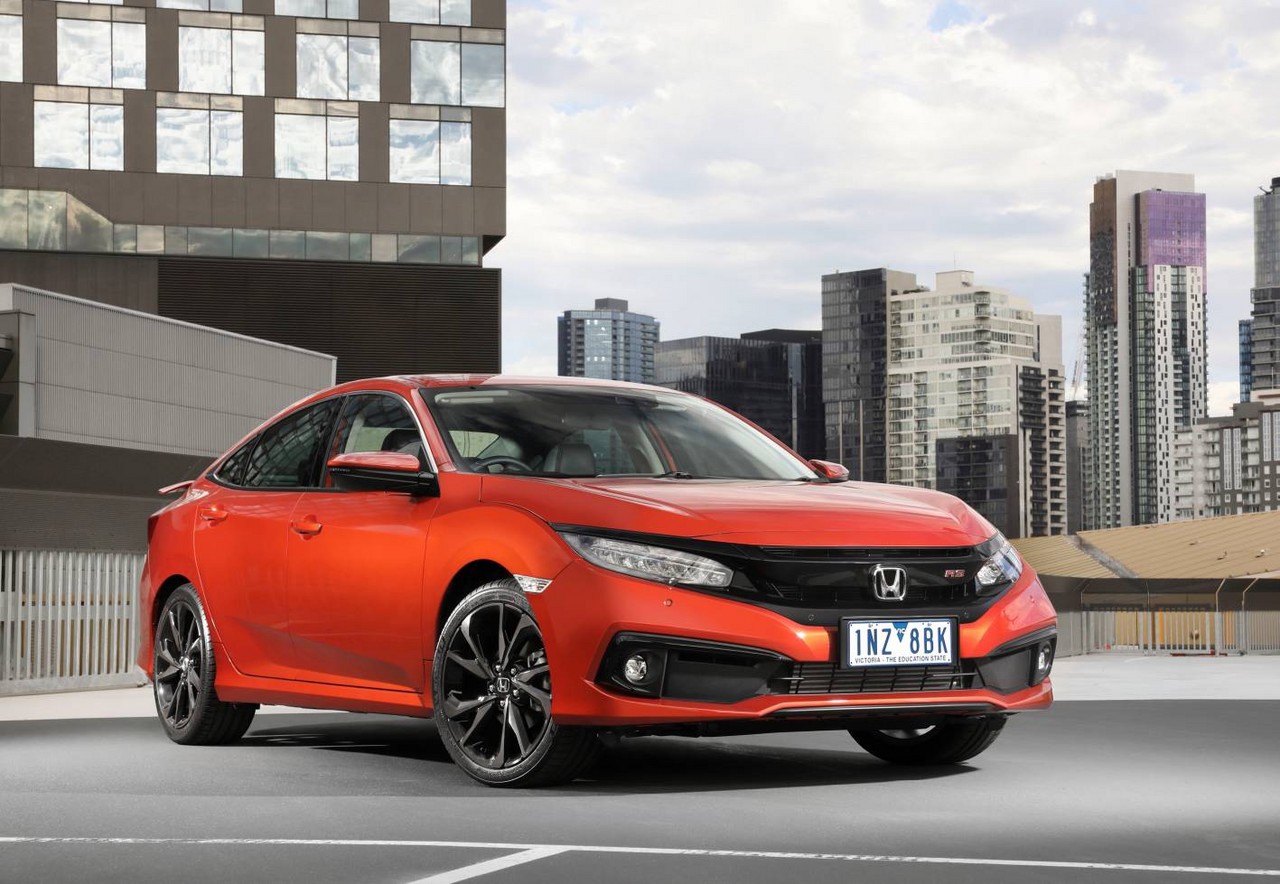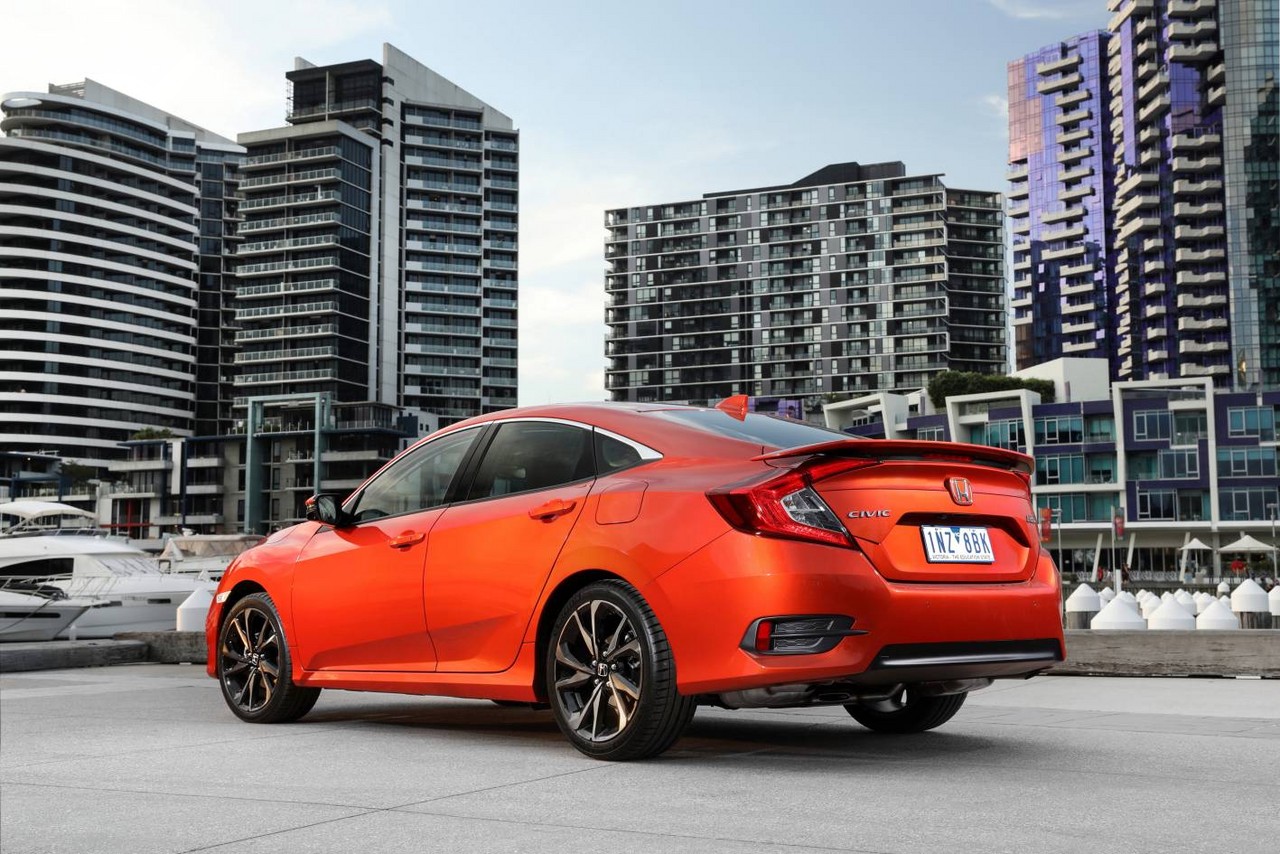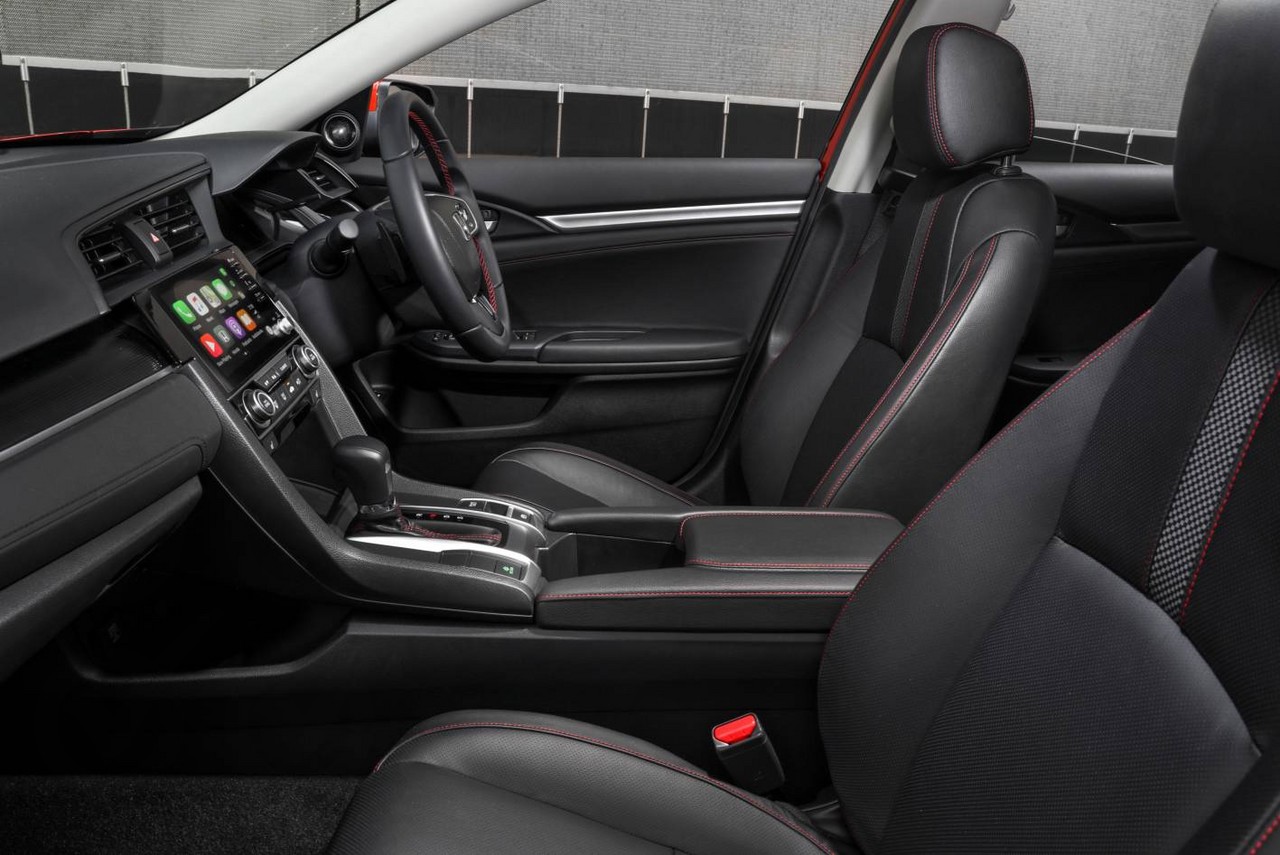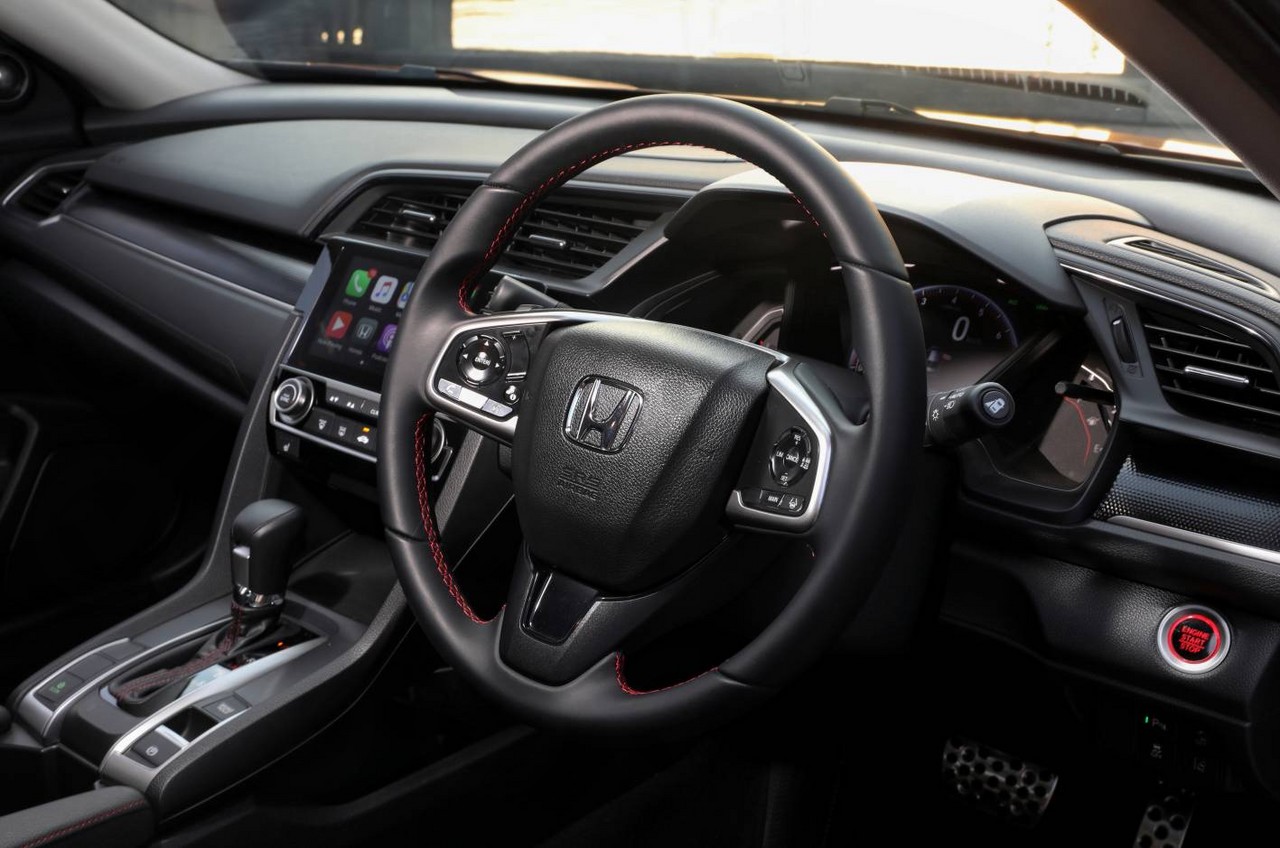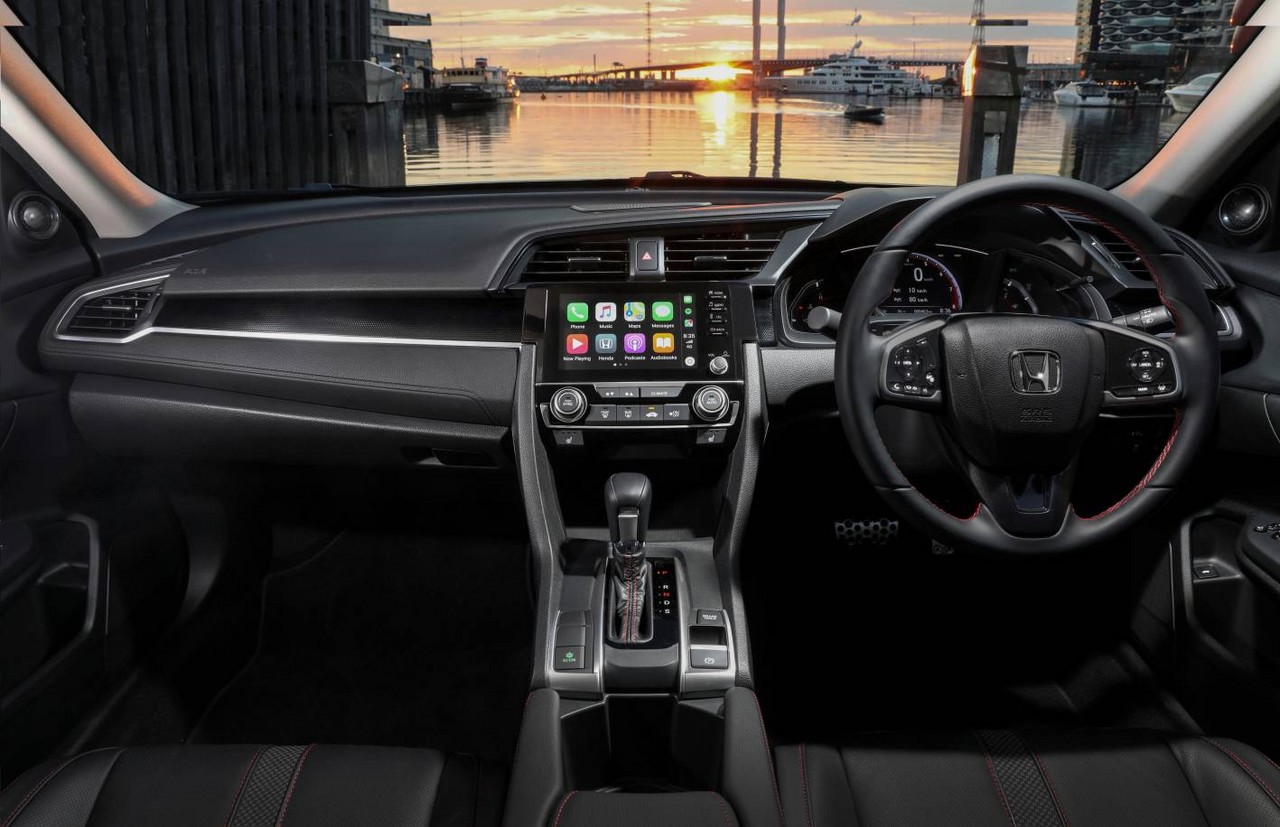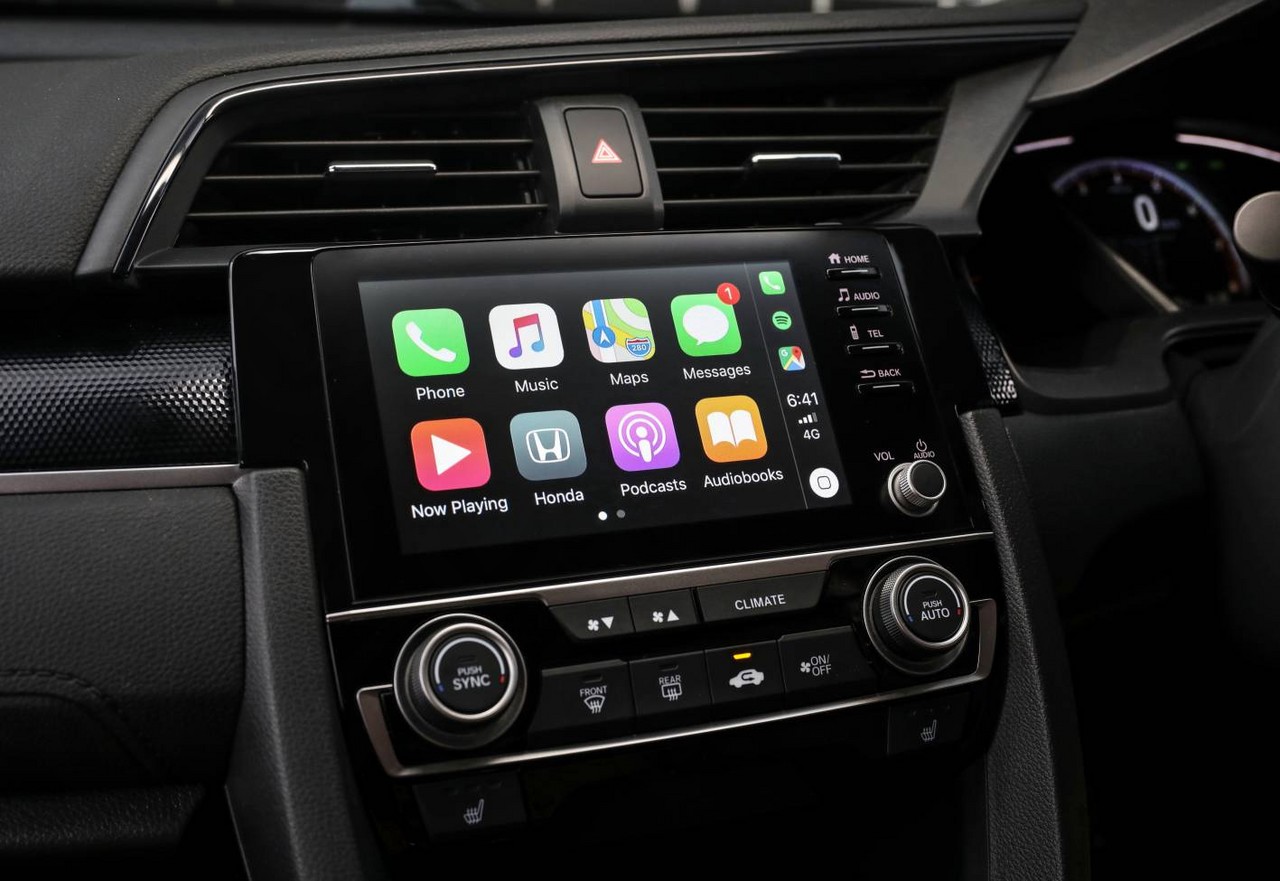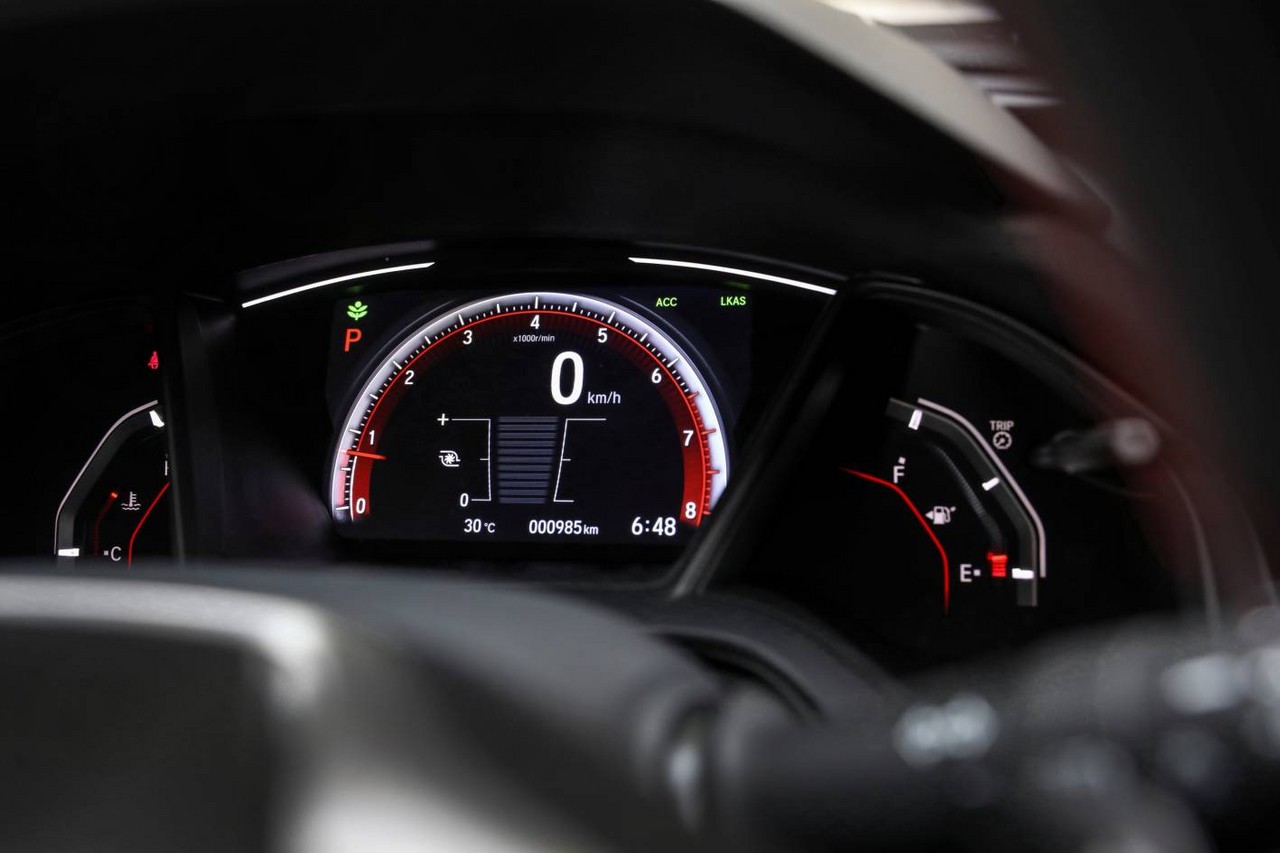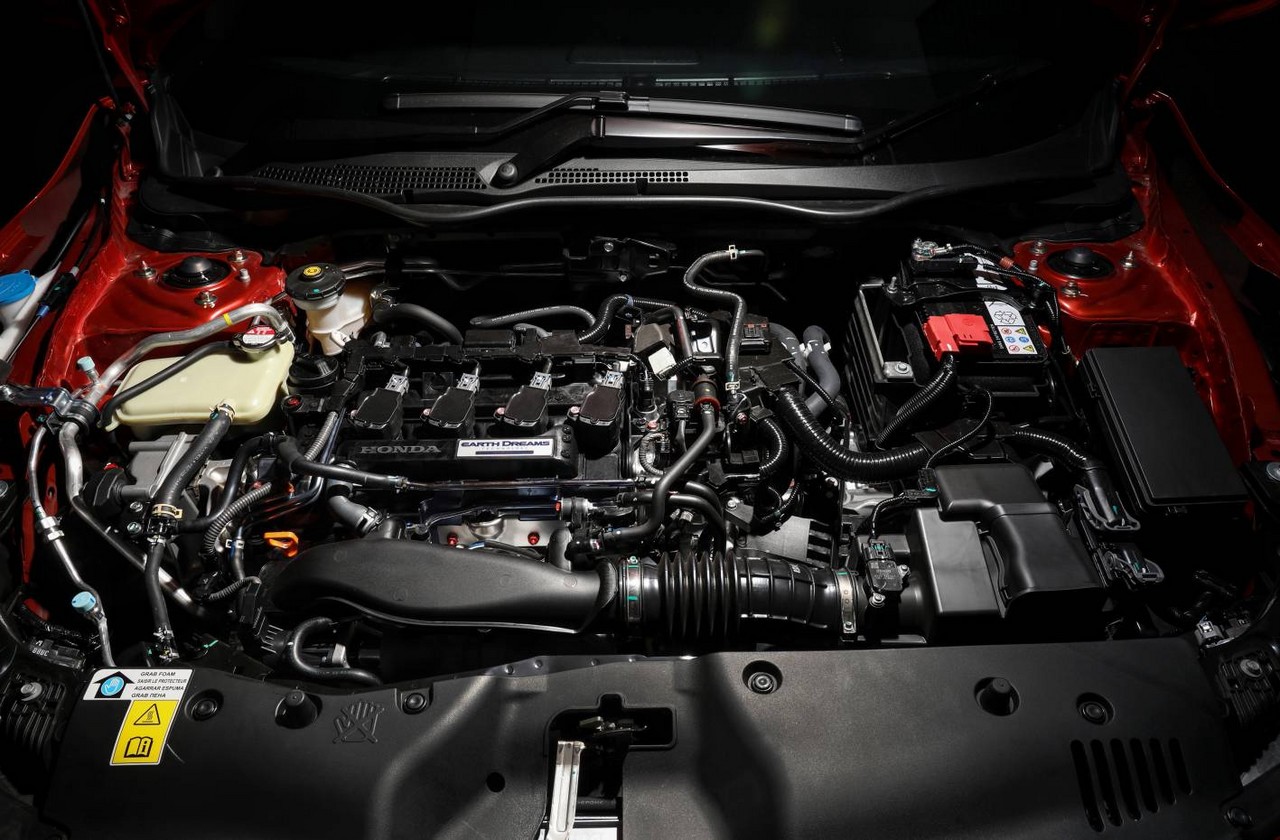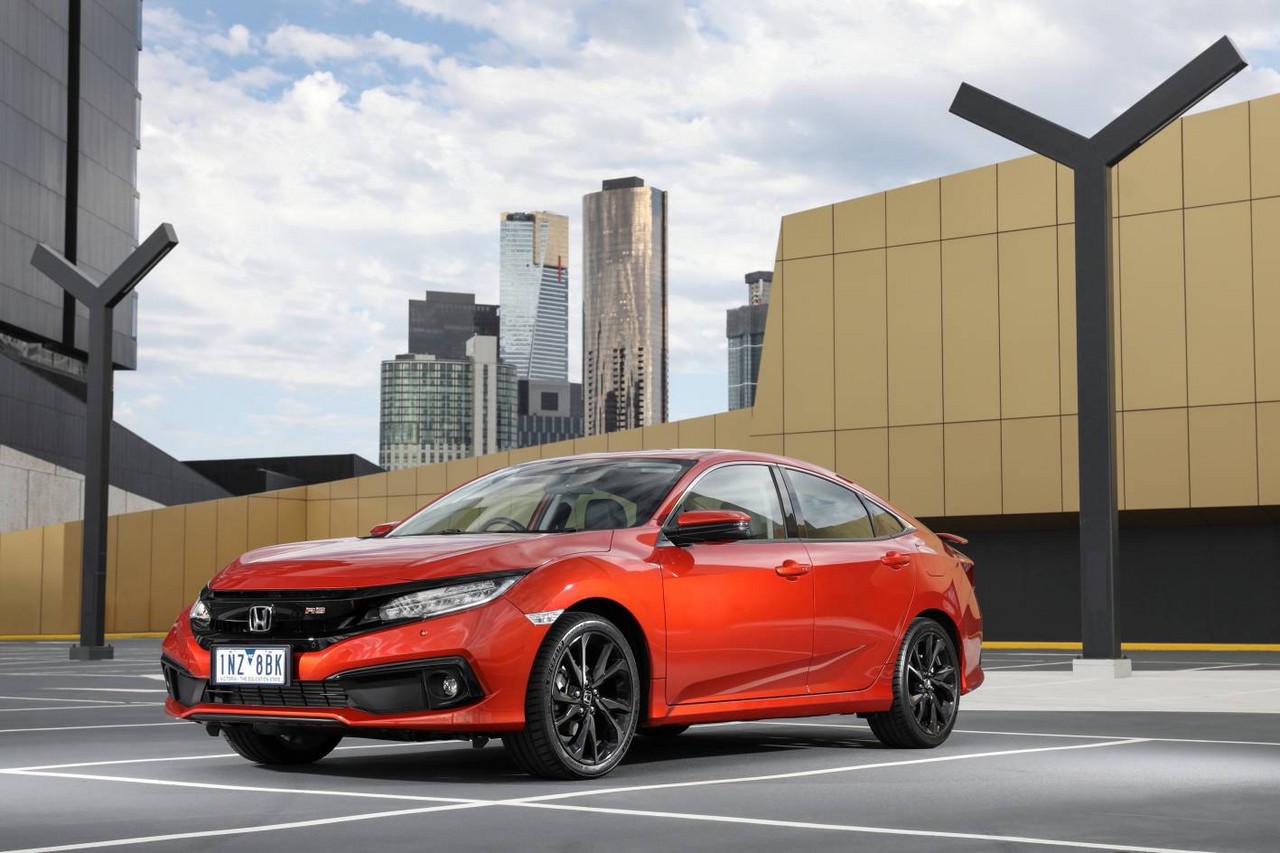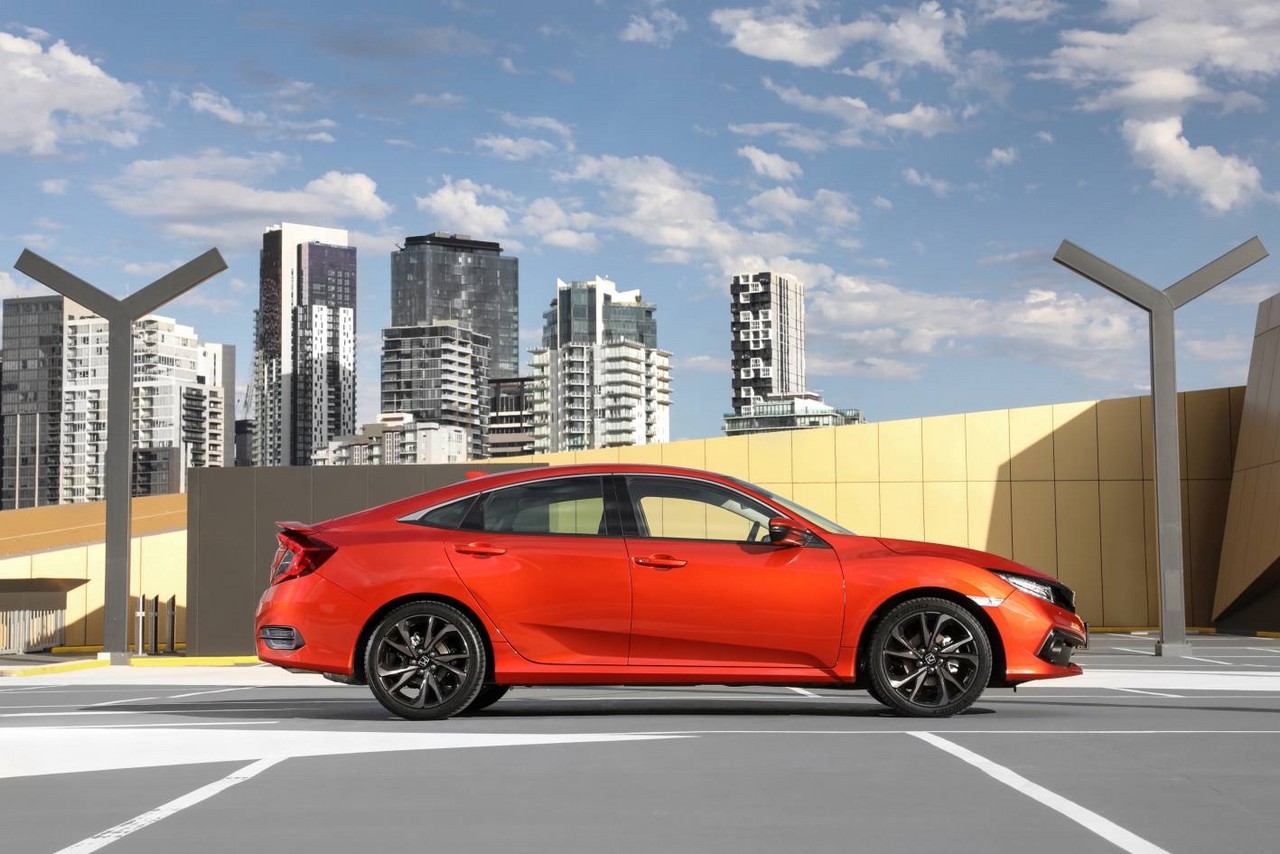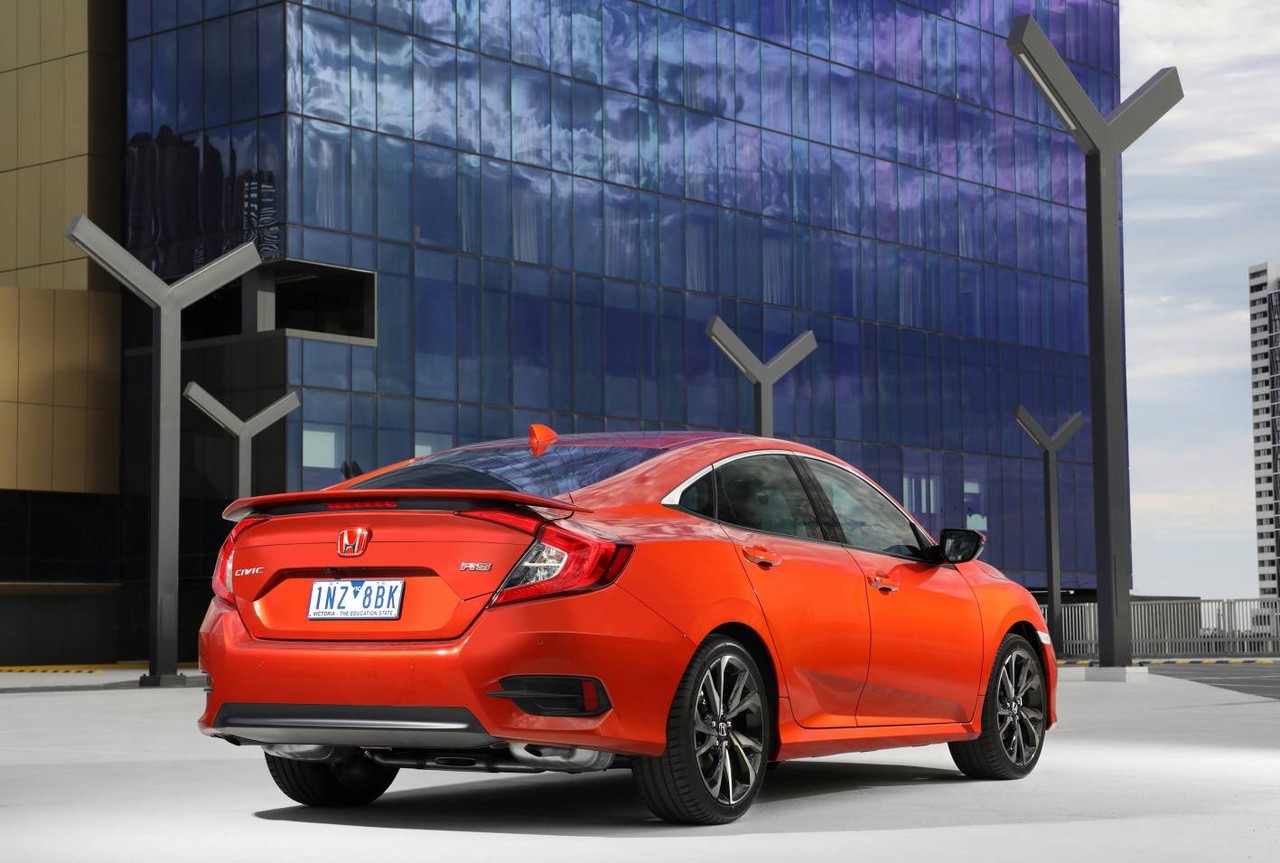
- Responsive 1.5-litre turbo petrol engine
- Spacious interior and boot
- Comfortable ride
- Well-weighted steering
- Handling prowess and chassis balance fall short of class leaders
- CVT contributes to sluggish throttle response
- Hard interior plastics
Review: Honda FC1.I/FC6.I Civic Sedan (2016-19)
Overview
Released in Australia in June 2016, the Honda FC1 and FC6 were small sedans that were powered by 1.5-litre turbocharged and 2.0-litre naturally aspirated petrol engines, respectively. Manufactured at Honda’s Prachinburi plant in Thailand, the front-wheel drive Honda FC1 Civic range consisted of VTi-L, RS and VTi-LX variants, while the FC6 Civic range consisted of VTi and VTi-S variants.
From 1 July 2017, the Honda FC1/FC6 Civic Sedan was sold with a five year, unlimited kilometre warranty; if the vehicle was used for commercial purposes, however, the warranty was limited to five years or 140,000 kilometres, whichever came first.
Honda FC6 Civic: R18Z1 engine
For the Honda FC6 Civic sedan, the 1.8-litre R18Z1 four-cylinder petrol engine had an aluminium-alloy block and cylinder head, a single overhead camshaft (chain-driven), four valves per cylinder, a variable length intake manifold, drive-by-wire throttle control and a compression ratio of 10.6:1. The engine also featured Honda’s i-VTEC (Intelligent Variable Valve Timing and Lift Electronic Control) system which used two distinct camshaft profiles to vary intake valve timing and lift for low RPM (1500-3500 rpm) and high RPM (5200-7000 rpm) operations.
Honda FC1 Civic: L15B7 engine
For the Honda FC1 Civic sedan, the L15B7 engine had a die-cast aluminium block with 73.0 mm bores and an 89.4 mm stroke for a capacity of 1496 cc. Within the block, the L15B7 engine has cast-in iron cylinder liners and the cylinder walls undergo a ‘plateau honing’ process to remove ‘microscopic high points’. Within the crankcase, the forged-steel crankshaft has micro-polished journals to reduce friction and the high-strength steel connecting rods are heat-forged in one piece and then ‘crack separated’ to create a light and stronger rod with an optimally fitted bearing cap. The aluminium pistons have an optimised skirt design to reduce reciprocating weight and a molybdenum coating for the outer skirts – applied in a dot pattern – to reduce friction. Furthermore, the pistons have ion-plated piston rings to reduce friction and are cooled by twin oil jets directed at the underside of each piston crown.
The L15B7 engine has a pressure-cast aluminium alloy cylinder head that contains chain-driven, hollow double overhead camshafts with electronically-controlled Variable Timing Control (‘VTC’) for both the intake and exhaust camshafts. Of the four valves per cylinder, the exhaust valves are sodium-filled for heat dissipation.
To eliminate the need for a separate exhaust manifold, exhaust ports are cast into the cylinder head. The L15B7 engine features a single-scroll MHI TD03 turbocharger which has a nine-blade turbine impeller, electronic waste gate and provided peak boost pressure of 1.15 bar (16.5 psi). Furthermore, the L15B7 engine has direct injection via multi-hole injectors and a compression ratio of 10.6:1.
| Model | Variant | Engine | Trans. | Peak power | Peak torque |
|---|---|---|---|---|---|
| FC6 Civic | VTi, VTi-S |
1.8-litre R18Z1 petrol I4 | CVT | 104 kW at 6500 rpm | 174 Nm at 4300 rpm |
| FC1 Civic | VTi-L, RS, VTi-LX |
1.5-litre L15B7 turbo petrol I4 | CVT | 127 kW at 6000 rpm | 220 Nm at 1700-5500 rpm |
Continuously Variable Transmission (CVT)
The Honda FC6/FC1 Civic had a continuously variable transmission (CVT) which consisted of an engine-driven torque converter which drove two variable-width pulleys that were connected by a steel belt. The steel belt had angled inner faces so that it could circle the angled pulley faces at varying diameters depending on the pulley width which adjusted the effective ratio between the pulleys. Computer control of the CVT enabled the ratio between the pulleys to be altered to suit driving conditions and accelerator pedal position.
For the turbocharged FC1 Civic, the CVT featured Honda’s “G-Design’ shift logic which Honda claimed to improve acceleration and provide ‘a more familiar driving feel’. Furthermore, a turbine twin-damper design for the torque converter was claimed to provide ‘tighter control’ and reduce turbo lag during acceleration.
Dimensions
Compared to the Honda FB2/FB3 Civic Sedan which it replaced, the FC1/FC6 Civic was 90 mm longer (at 4630 mm), 45 mm wider (1800 mm), 25 mm lower (1410 mm) and had a 30 mm longer wheelbase (2700 mm). Furthermore, the FC1/FC6 Civic had a boot capacity of 517 litres.
Suspension and steering
The Honda FC1/FC6 Civic had MacPherson strut front suspension and independent, multi-link rear suspension; both the front and rear suspension were mounted on sub-frames that were attached to the body using hydraulic compliance bushings. Furthermore, the FC1/FC6 Civic had bonded stabiliser bushings (front and rear) for more progressive anti-roll behaviour.
The Honda Civic had rack-and-pinion steering with electric power assistance. The steering incorporates dual-pinion gears for improved steering feel and variable gear ratios. Furthermore, the Civic’s steering wheel required 2.2 turns from lock-to-lock.
Safety equipment
Standard safety equipment for the Honda FC1/FC6 Civic included dual front airbags, front side airbags, full-length curtain airbags, ABS, electronic brake force distribution, brake assist, electronic stability control, traction control and front seatbelts with pre-tensioners and load limiters.
The Civic VTi-S, VTi-L, VTi-LX and RS were also fitted with Honda’s ‘LaneWatch’ system which used a camera to increase the view of the passenger-side mirror by up to 80 degrees, with the camera output visible on the multi-information display.
The Civic VTi-LX was also equipped with:
- Forward Collision Warning (FCW) and Collision Mitigation Braking System (CMBS): operating at speeds above 15 km/h, FCW and CMBS used millimetre-wave radar and a camera located in the windscreen to monitor the road up to 100 metres ahead. If FCW detected that there was a collision risk with the vehicle ahead, a ‘Brake’ warning would flash in the Multi-Information Display and an audible warning would sound. In its second stage, CMBS would apply light braking to reduce vehicle speed and alert the driver. In its final stage when a collision was assessed to be inevitable, CMBS would apply maximum braking force to reduce vehicle speed and the severity of the collision;
- Lane Keep Assist System (LKAS): used a camera to detect if the vehicle was departing from its lane without indicating and would automatically apply corrective steering inputs (‘Road Departure Mitigation System’). Visual and audible warnings would also be issued (‘Lane Departure Warning’, LDW); and,
- Adaptive Cruise Control (ACC): operated at speeds above 30 km/h and enabled the vehicle to maintain a specified distance from the vehicle ahead and could apply up to a quarter of the maximum braking force to slow the vehicle. For speeds below 40 km/h, a Low Speed Following (LSF) function could be engaged so that the Honda Civic VTi-LX would follow the vehicle ahead.
ANCAP safety rating
In ANCAP crash testing , the Honda Civic sedan received a five star adult occupant protection rating with a score of 34.68 out of 37. In the frontal offset tests, protection of the front occupants’ heads and upper legs were rated as good, though chest and lower leg protection were rated as adequate (i.e. a slight risk of serious injury). In the side impact test, protection of the head, abdomen and pelvis were rated as good, though chest protection was rated as adequate.
Features: Civic VTi
As standard, the Civic VTi was fitted with Honda’s ‘Advanced Display Audio’ system which included eight speakers, seven-inch colour touch screen, an AM/FM radio, Bluetooth mobile phone connectivity and audio streaming, USB connectivity, Apple CarPlay and Android Auto.
Other standard features for the Honda Civic VTi included 16-inch steel wheels, black fabric seat trim, single-zone climate control air conditioning, cruise control with speed limiters, halogen headlights, LED daytime running lights, a rear view camera with dynamic guidelines, 60:40 split fold rear seats, remote central locking, power door mirrors, power windows, tilt and telescopic steering wheel adjustment, a tyre deflation warning system, an alarm and immobiliser.
Features: Civic VTi-S and Civic VTi-L
Compared to the Civic VTi, the Civic VTi-S was further equipped with 16-inch alloy wheels, premium black seat trim, halogen front fog lights, parking sensors (front and rear), a leather-wrapped steering wheel, a proximity key (i.e. keyless entry) and push-button start. Furthermore, the Civic VTi-S could be identified by its door mirrors with integrated LED indicators.
Beyond this, the Honda Civic VTi-L added 17-inch alloy wheels, digital radio tuner (DAB+), dual-zone climate control air conditioning, dusk-sensing headlights, rain-sensing wipers, steering wheel gearshift paddles and rear privacy glass.
Features: Civic VTi-LX
Relative to the Civic VTi-L, the Civic VTi-LX was distinguished by its 452 watt audio system with ten speakers (including subwoofer), satellite navigation system with SUNA live traffic updates, leather seat trim, heated front seats, LED headlights, LED front fog lights, power sunroof, auto-dimming rear view mirror and leather-wrapped gearshift knob.
Features: Civic RS
Positioned as the sports variant within the range, the Honda Civic RS added to the features of the Civic VTi-L with a 452 watt audio system with ten speakers (including subwoofer), black leather seat trim, heated front seats, LED headlights with auto-levelling, LED front fog lights, power sunroof, leather-wrapped gearshift knob and drilled alloy sports pedals.
Visual cues for the Civic RS included its 17-inch sports alloy wheels, piano black grille treatment, piano black B- and C-pillars, chrome door handles and tailgate spoiler.
Honda Civic Black Pack
As an extra-cost option, the Honda Civic sedan could be specified with a ‘Black Pack’ which – for the Civic VTi, VTi-S, VTi-L and VTi-LX – consisted of:
- 17-inch black alloy wheels;
- A black front under spoiler;
- Black side skirt set;
- Black door mirror covers;
- A black ducktail spoiler; and,
- Black sports grille.
For the Civic RS, however, the black pack omitted the black ducktail spoiler and black door mirror covers.
2018 Honda Civic VTi-S Luxe
The Honda Civic VTi-S Luxe was released as a limited edition model in April 2018. Compared to the standard Civic VTi-S, the Civic VTi-S Luxe added:
- Leather-appointed seat trim;
- Heated front seats;
- An eight-way power adjustable driver’s seat;
- A ‘piano black’ front sports grille; and,
- Metallic/pearlescent paint.
The Honda Civic VTi-S Luxe had a manufacturer’s list price (MLP) of $24,490.
Brochure and specifications
Related links
Review: Honda FC1.II/FC6.II Civic Sedan (2019-on)
Overview
Released in Australia in March 2019, the Honda FC1 and FC6 Series II Civic Sedans introduced updated styling, revised interiors and ‘Honda Sensing’ active safety technologies for the Civic RS and VTi-L.
Visually, the FC1.II/FC6.II Civic Sedans could be identified by their redesigned front bumper, new lower grilles and matching gloss black finishes for the lower grille garnishes and fog light surrounds. For all Civic Sedans other than the VTi variants, the upper grille had a piano black finish. Beyond this, new wheels designs were introduced for the Civic VTi and VTi-S, the Civic RS was fitted with wider 18-inch alloy wheels with 235/40 ZR18 95Y Michelin Pilot Sport 4 tyres and the Civic VTi-LX was fitted with the same 17-inch alloy wheels as the FC1 Civic RS, but with a dark grey finish.
Inside, the FC1.II/FC6.II Civic Sedans featured:
- New dashboard trim inserts which had a ‘geometric embossed’ finish;
- New seat trims for Civic VTi-S, VTi-L, RS and VTi-LX, with red seat-trim stitching for the Civic RS;
- For ‘Advanced Display Audio’ system, hard keys for commonly used functions (i.e. Home, Audio, Telephone and Back) and a dedicated volume control knob ‘for a more intuitive user experience’;
- For Civic RS and VTi-LX, push buttons for one-touch adjustment and control of fan speed; and,
- A steering wheel-mounted rocker switch was introduced for remote volume control.
| Model | Variant | Engine | Trans. | Peak power | Peak torque |
|---|---|---|---|---|---|
| FC6.II Civic | VTi, VTi-S |
1.8-litre R18Z1 petrol I4 | CVT | 104 kW at 6500 rpm | 174 Nm at 4300 rpm |
| FC1.II Civic | VTi-L, RS, VTi-LX |
1.5-litre L15B7 turbo petrol I4 | CVT | 127 kW at 6000 rpm | 220 Nm at 1700-5500 rpm |
Safety equipment
For the FC1.II Civic, the VTi-L and RS variants were fitted with the ‘Honda Sensing’ safety technologies that were previously limited to the Civic VTi-LX, i.e. Forward Collision Warning (FCW), Collision Mitigation Braking System (CMBS), Lane Keep Assist System (LKAS), Road Departure Mitigation System (RDMS), Lane Departure Warning (LDW) and Adaptive Cruise Control (ACC) with Low Speed Following (LSF).
For the FC1.II Civic, the ‘Honda Sensing’ safety technologies were extended to include Honda’s ‘High Beam Support System’ (HBSS) which would automatically engage high beam headlights on clear roads and switch to low beams when oncoming traffic was detected.
Features
For the FC6.II Civic VTi-S, standard features were extended to include rear privacy glass.
For the FC1.II Civic VTi-L, RS and VTi-LX, standard features were extended to include power retractable door mirrors with an auto-fold function.
For a complete list of features, please refer to the brochure below.
Brochure and specifications
Related links
